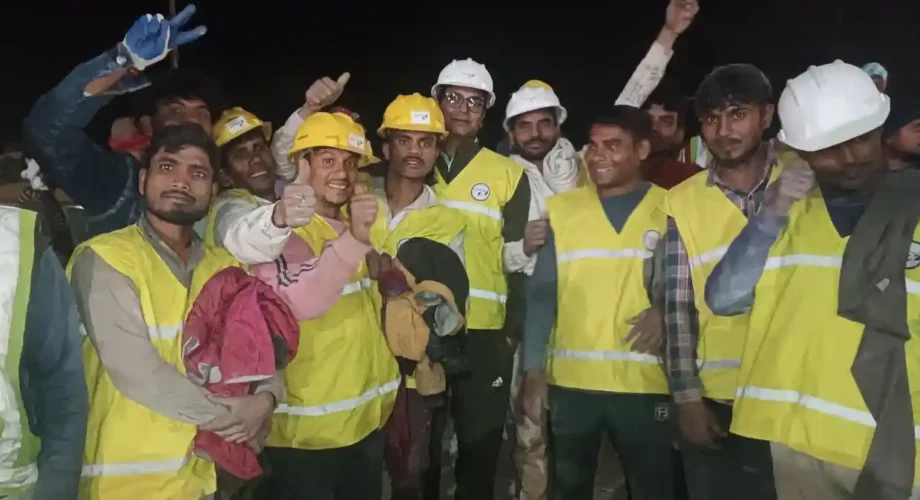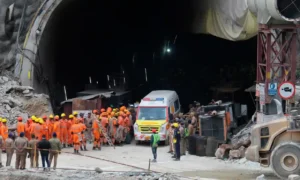
All 41 workers were rescued from inside the under-construction Silkyara-Barkot tunnel in Uttarkhand, India, after being trapped for 17 days.
Most of the men had travelled hundreds of miles to find employment. Tunnel digging and construction is often dangerous and back-breaking work, but for the dozens of labourers working on the Silkyara-Barkot tunnel, high up in the Indian Himalayan mountains, they felt they had little choice.
Some had been doing this for work for than two decades, and a few had come close to disasters before. But none of them had ever dreamed of what would happen in the early hours of 12 November, when a rumbling noise was the first sign that they were in trouble.
It took a gruelling 17 days to rescue the 41 labourers who became trapped, after the entrance to the road tunnel they had been constructing collapsed, following a suspected landslide, and their exit was blocked by more than 60 metres of rubble, debris and metal.
One of India’s largest rescue operations, involving heavy drills and bulldozers, engineers, army and air force personnel, took on the challenge but faced endless obstacles in the fragile mountain terrain of Uttarakhand. Ultimately, it was a team of “rat miners” with expertise is in underground burrowing who managed to break through the debris by hand and reach them.
“Those were terrible days. It felt like death was near,” said Sushil Kumar, one of those who were trapped in the tunnel, speaking from hospital. “There was this constant thought of ‘will we be able to get out of here?’. I would think about my family, my children and cry.”
Kumar, 33, had travelled 1,500km from his home state of Bihar for the job, and had been working on the tunnel as a crane operator for five years. Bihar is one of India’s most impoverished states, where work is hard to come by, and his monthly salary from the tunnel construction, 26,000 rupees, was more than he could earn locally.
Kumar said he initially felt lucky as he was around 2km from the entrance when the ceiling collapse occurred. But soon, as the men realised they were stuck, dread kicked in. “I felt very scared, there was the fear that the entire tunnel might collapse and we would get buried under its rubble,” he said.
The first few days were the worst, when they had only puffed rice to survive on and oxygen levels began to dip, making them all dizzy. “Everyone was feeling weak and it felt like we would not survive,” said Kumar. “My body was shaking after a few days. I could not walk properly, my legs would tremble.”

But as they established communication with the outside world through a small water pipe, and oxygen and dried fruit began to be funnelled into the cavity, the mood among the men gradually picked up. They would sit together and talk, sharing stories, and consoling each other. Kumar made playing cards out of paper and they kept themselves entertained with games for hours. Assurances and messages of optimism from rescuers outside “kept us alive” he added.
After the 10th day, when a larger pipe was inserted into the tunnel and phone chargers and proper food could reach the men, they were overjoyed. The men would gather round a phone to watch films and play games. “I would also go through the photo gallery of my phone every day looking at the pictures of my children and wife, it really helped,” he said. “But still, we were getting more frustrated with each passing day.”
Vijay Kumar, 19, another of the labourers who is from the state of Himachal Pradesh, described how the men had made beds out of the tarpaulin sheets used for waterproofing the tunnel and had collected dripping water in jerrycans. An area at the end of the tunnel, 2km away, was the designated toilet.
“The first 24 hours were the most difficult,” he said. “Everyone was anxious and worried because there was no communication outside. We had no idea if the engineers outside were even aware of the collapse and how massive it was. It was very scary.”
Access to games and films on his phone also kept him entertained, but being trapped in the confined space also took a toll physically. “Our bodies got weak during this time. I had a bad body ache and it was mentally exhausting,” he said.
Both men said they would never forget the moment that the rescuers finally emerged through the wall of rubble that had been blocking their way to freedom. “We were overwhelmed with joy. Everyone was laughing and crying. I have never felt so good in life,” said Sushil Kumar.
Nonetheless, the collapse of the tunnel has raised questions over the safety of the construction, and the risks that labourers are forced to endure when working at high altitude. The Silkyara-Barkot tunnel is part of the Char Dham project, a mammoth $1.5bn enterprise to widen roads across the state of Uttarakhand and connect four popular pilgrimage sites. It is one of the flagship infrastructure projects of the prime minister, Narendra Modi, who inaugurated it in 2016.
But the project has faced objections and legal challenges from environmentalists, who argued that the project – which involves cutting deep into the mountainside – was pushed through at speed and ignored safety and environmental concerns over landslides, subsidence and other high risks involved when disturbing the fragile Himalayan mountains. After the government utilised a loophole, no environmental risk assessment was carried out for the Silkyara-Barkot tunnel or any stretch of the Char Dham project, which was challenged in India’s environmental courts in 2018.
Dharam Singh, 49, Vijay Kumar’s father, who has also worked in construction all his life said he was “so grateful” for his son’s safe return but added: “Why is it only after a tragedy that everyone wakes up to the dangers. The company should be made answerable for this.”
Singh questioned why the collapsed tunnel did not have an escape route, as is usually mandated for safety purposes.
“There is always a possibility that a tunnel can collapse, that is why there has to be an escape route,” he said. “This collapse and trapping of workers shows us how these places are not very safe. The companies which get contracts to build these tunnels earn huge money but they are not willing to spend on the safety of their workers.”
But while Sushil Kumar and Vijay Kumar said they were disillusioned and traumatised by their time stuck in the tunnel, and had little desire to return to the risky work, both said they felt they had little choice.
“I wish there was some other work I could do,” said Vijay Kumar. “I never want to go back in that tunnel but the only job I know how to do is operating that machine. There is always danger but I don’t know how else I will sustain my family.”